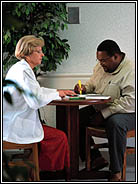 Outpatient Diabetes Services
Outpatient Diabetes Services
Learning More About Diabetes
While there is no cure for diabetes, it can be controlled with life-style changes and/or medication. For people living with diabetes, their daily
goal is to maintain a delicate balance between the sugar in their diet and insulin. This will help them control acute symptoms, prevent long-term complications and promote better overall health.
As difficult as that may seem, diabetes management is similar to leading a healthy life-style based on educated
decisions, meal planning and exercise.
Lincoln Medical Center's diabetes staff plays an important role in helping primary care physicians
help patients successfully self-manage their disease. Through individual and small group sessions,
patients and their family members learn about topics such as meal planning, exercise regimens and the
importance of checking blood sugar levels regularly.
Outpatient Diabetes Services staff consists of two Certified Diabetes Educators (CDE);
one is a Registered Nurse and a Registered Dietitian.
Outpatient Diabetes Services include:
- Individual assessment and instruction in diabetes self-management skills
- Group classes, minimum four to six hours
- Individual one-to-two hour sessions as indicated
- Follow-up and reinforcement at regular intervals to assess progress with lifestyle changes and long-term control
- Phone consultations as questions arise
- Monthly education/support sessions offered at no charge
What Is Diabetes?
This disease affects the body's ability to use and/or produce insulin. Insulin - a hormone produced by the pancreas
- acts like a gate keeper, transferring sugar from the bloodstream into cells where it is converted into energy.
If the person's blood sugar level rises too high, too quickly, it can create immediate symptoms of nausea, blurred
vision, sleepiness and feelings of weakness. Over time, the cumulative effects of abnormally high blood sugar
levels may result in circulation problems.
 Patients can have one of two types of diabetes. Type 1 diabetes is caused by insulin deficiency. Because the person's pancreas has stopped producing insulin, his or her blood sugar levels can rise extremely high. Insulin injections are needed to keep them under control. Symptoms of high blood sugar levels includes becoming very sick quickly, lethargy, inability to function and frequent urination. This form is common in children, adolescents and adults under 30.
Patients can have one of two types of diabetes. Type 1 diabetes is caused by insulin deficiency. Because the person's pancreas has stopped producing insulin, his or her blood sugar levels can rise extremely high. Insulin injections are needed to keep them under control. Symptoms of high blood sugar levels includes becoming very sick quickly, lethargy, inability to function and frequent urination. This form is common in children, adolescents and adults under 30.
Type 2 diabetes, traditionally the adult form of the disease, is now appearing more often in
young patients due to life-styles. Usually starting at age 35 to 40, this disease is due to
insulin resistance. The cells in the person's body have trouble receiving sugar from the blood
stream and therefore are unable to produce energy. The liver tries to compensate for the lack of
energy by releasing even more sugar into the blood stream. This overcompensation may go on for
several years before the person experiences symptoms such as thirst, increased frequency of
urination, blurred vision, extreme tiredness and sores that will not heal.
For more information about Outpatient Diabetes Services, call 704-732-5153.
|




